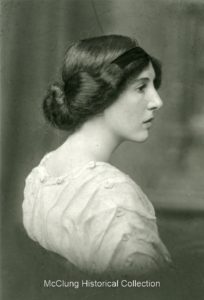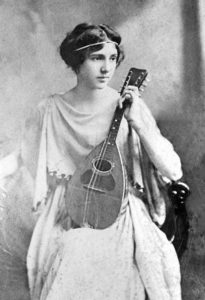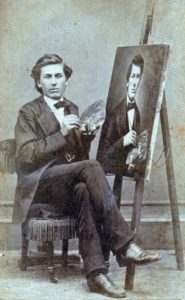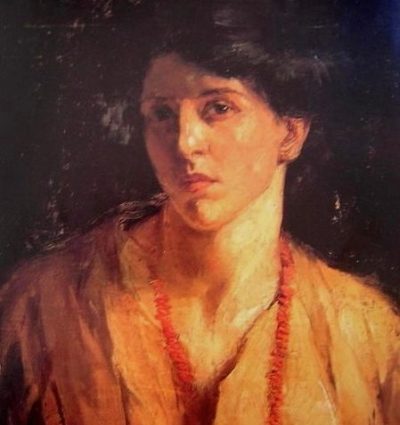A few years ago, I visited the Coal Creek Miners Museum in Rocky Top (formerly Lake City, formerly Coal Creek), Anderson County, Tennessee. The facility provides a historical glimpse into the lives of coal miners in the Fraterville and Briceville mines, particularly from the late 1800s to the 1930s. The museum houses a variety of miner equipment such as tools, uniforms, miner hats (including open flame), lunch buckets, etc. The walls are covered with an array of historical information. On a far end, amidst all the mining material, a small section is devoted to a lone woman, an artist named Anna Catherine Wiley.

Anna Catherine Wiley was born in Coal Creek, Tennessee, on January 9, 1879 to Edwin Floyd Wiley and Mary Catherine McAdoo Wiley.1)Blues, Evening. Find A Grave. Jan 15, 2004. (accessed Feb 2021). Coal Creek was a booming town with coal deposits several layers deep inside adjacent mountains. The coal there was of the highest quality and purchased by cities across the southeast. So, what does coal have to do with Catherine Wiley the artist? Well, her connection to the mineral substance began with her paternal grandfather, Henry Howard Wiley. He was a pretty crafty civil engineer2)Thacker, Barry. “Preserving Coal Creek Mining History.” Coal Creek Watershed Foundation, Inc. July 7, 2012. (accessed Mar 2021). and businessman. He partnered with lawyer William McEwen “for the purpose of acquiring and clearing the titles to several 5000-acre tracts of coal-bearing lands.”3)Coal Creek Watershed Foundation, Inc. “In Search of the Big Chestnut.” Coal Creek Watershed Foundation, Inc. May 16, 2014. (accessed Mar 2021). He ran his first coal mine in 1847 and later formed the Coal Creek Mining and Manufacturing Company,4)Thacker, Barry. “Preserving Coal Creek Mining History.” Coal Creek Watershed Foundation, Inc. July 7, 2012. (accessed Mar 2021). which, after some dealings with Knoxville and “New York financiers,”5)As I understand, Knoxville community leaders and New York bankers coerced H. H. Wiley through a series of law suits that contested his coal assets. If things continued in this direction, Wiley faced the draining of his fortune, so, he made a deal that gave Knoxville and New York the land, “while the financiers provided capital and connections.” provided land for the operations.6)Coal Creek Watershed Foundation, Inc. “In Search of the Big Chestnut.” Coal Creek Watershed Foundation, Inc. May 16, 2014. (accessed Mar 2021). Catherine’s father, Edmond, followed in Henry’s footsteps and later formed the Wiley Coal Company, which “was active from July 1881 to March 13, 1909.”7)Revans. “Coal Creek Mining and Mfg. Co.” TNGenWeb: Anderson County Tennessee Genealogy & History. Aug 7, 2011. (accessed Mar 2021).
“Life – that is the word! . . . The pæan of life, ever changing, now tremulous and fine, now vibrant and strong, but always and ever Life! And it is a world of light and air and color!” — Catherine Wiley8) Wiley, Catherine. “Anna Catherine Wiley Lecture XVIII The Mind in Art; Modern Painting.” In The Woman’s Athenaeum: For the Intellectual Industrial and Social Advancement of Women, by The Woman’s Athenaeum, 176-188. New York: The Woman’s Athenaeum [?], 1912.

Catherine attended public schools as a young girl. In 1895, at just sixteen years old, she enrolled at the University of Tennessee, Knoxville (UTK), making her one of the first female students to attend the college. She drew illustrations for the university’s yearbook, which brought her notice.9)Moore, Elizabeth H. “Anna Catherine Wiley.” Tennessee Encyclopedia. Mar 1, 2018. (accessed Mar 2021). Yet Catherine didn’t want the same old mundane art training that prepared women, for the most part, to work as illustrators. In 1903, she packed her bags and went to New York to study at the Art Students League.10)Moore, Elizabeth H. “Anna Catherine Wiley.” Tennessee Encyclopedia. Mar 1, 2018. (accessed Mar 2021). She often painted women “amid their daily lives,”11)The Johnson Collection. “Wiley, Catherine (1879- 1958).” The Johnson Collection. Unknown. (accessed Mar 2021). as well as “interior” paintings.12)Moore, Elizabeth H. “Anna Catherine Wiley.” Tennessee Encyclopedia. Mar 1, 2018. (accessed Mar 2021). Her style had a “new impressionist quality”13)Creekmore, Betsey B. and Special Collections and University Archives. University of Tennessee. “Anna Catherine Wiley Sketches Collection.” The University of Tennessee Knoxville Special Collections . May 25, 2006. (accessed Mar 2021). and was considered to be the “American adaptation of Monet’s Impressionism.”14)The Johnson Collection. “Wiley, Catherine (1879- 1958).” The Johnson Collection. Unknown. (accessed Mar 2021). Her successes and art advocacy brought acceptance and appreciation to southern women artists.15)Moore, Elizabeth H. “Anna Catherine Wiley.” Tennessee Encyclopedia. Mar 1, 2018. (accessed Mar 2021).
She returned to Knoxville in 1905 and taught art at UTK for fourteen years.16)Moore, Elizabeth H. “Anna Catherine Wiley.” Tennessee Encyclopedia. Mar 1, 2018. (accessed Mar 2021).. The art program was (oddly) within the School of Home Economics at the time. Catherine established a more “formal art instruction”17)Unknown. “About Anna Catherine Wiley.” Anna Catherine Wiley. Unknown. (accessed Feb 2021). and the department became “one of the best in the South.”18)Moore, Elizabeth H. “Anna Catherine Wiley.” Tennessee Encyclopedia. Mar 1, 2018. (accessed Mar 2021). Upon her return to Knoxville, Catherine received additional training from portrait and outdoor artist, Lloyd Branson, “the first Knoxvillian who made an entire career of art” (more about him later). Also during this time, she penned art reviews for the Knoxville newspaper.19)Unknown. “About Anna Catherine Wiley.” Anna Catherine Wiley. Unknown. (accessed Feb 2021).
Catherine flourished during this time. She was a key figure in the Nicholson Art League in Knoxville – a group well known for their artistic talents. She won “Most Meritorious Collection” at the Appalachian Exposition in Knoxville, 1910, and she was awarded the best southern artist at the 1917 Southwestern Fair in Atlanta, Georgia.20)Moore, Elizabeth H. “Anna Catherine Wiley.” Tennessee Encyclopedia. Mar 1, 2018. (accessed Mar 2021). Her goal was always to portray the “inner life” of her models, as Wiley herself says:
Only when paintings make us realize more acutely the poetry that lies within us all, the romance that we ourselves feel, the power of our own spirit, the “externalisation” [sic] of our own soul, as it were – only then it has a meaning.21)The Johnson Collection. “Wiley, Catherine (1879- 1958).” The Johnson Collection. Unknown. (accessed Mar 2021).
She gained attention for women artists throughout Appalachia and the South, chairing the Fine Arts Department for National Conservation Exposition, and exhibiting paintings at various sites across the United States.

Just when Catherine’s artwork received recognition and praise, she plummeted — hard. In 1926, she had “a ‘mental breakdown’”22)Moore, Elizabeth H. “Anna Catherine Wiley.” Tennessee Encyclopedia. Mar 1, 2018. (accessed Mar 2021). and remained hospitalized until she died in 1958. Her mental decline was evident some time before the hospitalization. Her artwork took on “darker tones” moving toward Expressionism that “manifested in the form of urgent brushwork and hollow-eyed figures.”23)The Johnson Collection. “Wiley, Catherine (1879- 1958).” The Johnson Collection. Unknown. (accessed Mar 2021). As far as anyone knows, she never painted again after entering the hospital.24)Blackerby, Mike. “Tennessee Painting Fetches Record Price.” Knoxville News Sentinel, Jan 30, 2012: Front.
The most obvious question is . . . What happened? Sources vary on the reasons and that makes it quite the mystery. Some sources write that Catherine and the aforementioned Lloyd Branson were lovers. Neither of them ever married and one source hints that a particular painting, The Nude (1911), within which a woman hides her face (Find the image here.), is an image of Catherine. Certainly, if they weren’t lovers, they were devoted friends. Sources say the deaths of her father (d. 1919) and Branson (d. 1925) drove her to madness. Personally, I would add a bit more information (not that anyone can discern her rationale). I think the reason may have been a totality of deaths. Her brother, librarian and English professor, Edwin M. Wiley, died in 1924. And her mother died in 1926, the year she was hospitalized.25)The Johnson Collection. “Wiley, Catherine (1879- 1958).” The Johnson Collection. Unknown. (accessed Mar 2021). So, in six years, from age 40 to 47, she lost her mother, father, brother, and intimate friend. If anyone has ever experienced the deaths of several close persons – one right after another – in such a short time period, that person knows a soul-crushing suffering.
Anna Catherine Wiley died May 16, 1958 in Philadelphia County, Pennsylvania, and she’s buried at the Old Gray Cemetery in Knoxville, Tennessee. She was a renowned Appalachian impressionist whose paintings and sketches have recently gained popularity – and value. As recently as 2012, her untitled painting of a mother and child sitting in a meadow was purchased by the Knoxville Museum of Art for $107,000.26)Blackerby, Mike. “Tennessee Painting Fetches Record Price.” Knoxville News Sentinel, Jan 30, 2012: Front. Catherine Wiley has a historical marker located in downtown Knoxville on the corner of Union Avenue and South Gay Street. I’ll end here with a quote Catherine once wrote about art:
. . . we cannot fail to broaden our horizon; to find new beauties all around us, and to gain a deeper sympathy with the various aspects of life. We all need this enlargement of vision. America needs art to help her above materialism; and we, the women of America, in many ways the arbiters of taste of our nation, need it not only for its practical help in our homes, but in that larger sense of personal culture . . .27) Wiley, Catherine. “Anna Catherine Wiley Lecture XVIII The Mind in Art; Modern Painting.” In The Woman’s Athenaeum: For the Intellectual Industrial and Social Advancement of Women, by The Woman’s Athenaeum, 176-188. New York: The Woman’s Athenaeum [?], 1912.
Search the following sites to view more of Catherine Wiley’s work:
Sketches – University of Tennessee Library Special Collections
American Gallery
Artnet 1
Artnet 2
BONUS: Catherine’s sister, Eleanor McAdoo Wiley, was also an artist. Part of her collection can be found here.
**Featured Image: Catherine Wiley, Self-Portrait circa 1910s from Wikimedia
References
| ↑1 | Blues, Evening. Find A Grave. Jan 15, 2004. (accessed Feb 2021). |
|---|---|
| ↑2, ↑4 | Thacker, Barry. “Preserving Coal Creek Mining History.” Coal Creek Watershed Foundation, Inc. July 7, 2012. (accessed Mar 2021). |
| ↑3, ↑6 | Coal Creek Watershed Foundation, Inc. “In Search of the Big Chestnut.” Coal Creek Watershed Foundation, Inc. May 16, 2014. (accessed Mar 2021). |
| ↑5 | As I understand, Knoxville community leaders and New York bankers coerced H. H. Wiley through a series of law suits that contested his coal assets. If things continued in this direction, Wiley faced the draining of his fortune, so, he made a deal that gave Knoxville and New York the land, “while the financiers provided capital and connections.” |
| ↑7 | Revans. “Coal Creek Mining and Mfg. Co.” TNGenWeb: Anderson County Tennessee Genealogy & History. Aug 7, 2011. (accessed Mar 2021). |
| ↑8, ↑27 | Wiley, Catherine. “Anna Catherine Wiley Lecture XVIII The Mind in Art; Modern Painting.” In The Woman’s Athenaeum: For the Intellectual Industrial and Social Advancement of Women, by The Woman’s Athenaeum, 176-188. New York: The Woman’s Athenaeum [?], 1912. |
| ↑9, ↑10, ↑12, ↑15, ↑16, ↑18, ↑20, ↑22 | Moore, Elizabeth H. “Anna Catherine Wiley.” Tennessee Encyclopedia. Mar 1, 2018. (accessed Mar 2021). |
| ↑11, ↑14, ↑21, ↑23, ↑25 | The Johnson Collection. “Wiley, Catherine (1879- 1958).” The Johnson Collection. Unknown. (accessed Mar 2021). |
| ↑13 | Creekmore, Betsey B. and Special Collections and University Archives. University of Tennessee. “Anna Catherine Wiley Sketches Collection.” The University of Tennessee Knoxville Special Collections . May 25, 2006. (accessed Mar 2021). |
| ↑17, ↑19 | Unknown. “About Anna Catherine Wiley.” Anna Catherine Wiley. Unknown. (accessed Feb 2021). |
| ↑24, ↑26 | Blackerby, Mike. “Tennessee Painting Fetches Record Price.” Knoxville News Sentinel, Jan 30, 2012: Front. |









This article left me wanting to know more details. What type of mental illness did she have that was so severe she couldn’t have been kept at home? What was the nature of the institution where she lived? Maybe another article?
Hello Linda. I’m curious about all that as well. I do know she was hospitalized in Pennsylvania, and I did see several places there that aren’t necessarily “institutions” but are more like “airy homes,” if you will. But every source says she was definitely “hospitalized.” I’m guessing there weren’t many family members left who could take care of her. She had a couple of sisters, one of whom was also an artist, but I didn’t find much information on her. I’ll definitely look into it and do a little more digging.